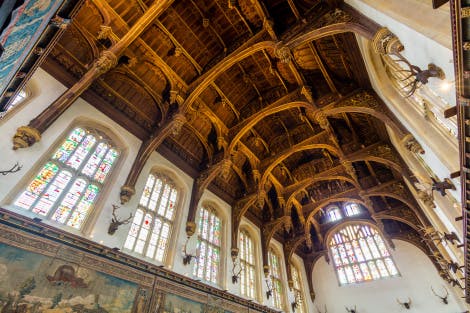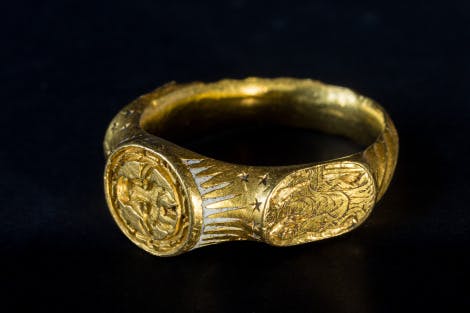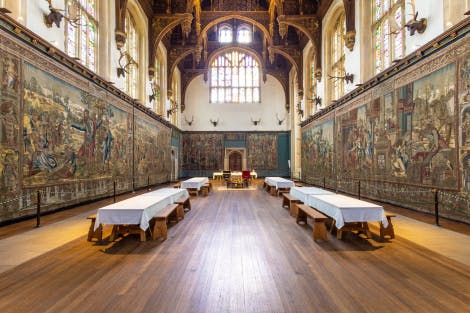Henry VIII’s insanely vast hammerbeam ceiling for his Great Hall at Hampton Court Palace. Built from 1532 onward using the skills of his shipbuilders. A work of the highest craftsmanship and engineering genius.
By the time that Henry VIII’s carpenters began working on the huge timber roof of the Great Hall in 1533, the King had divorced his first wife Katherine of Aragon and was married to his second, Anne Boleyn.
To celebrate Henry and Anne’s marriage, the carpenters added Anne’s coat-of-arms to the roof and carved the entwined letters H and A on the wooden screen at the end of the Great Hall. These poignant reminders of Anne’s time as Queen can still be seen today.
Also featured in the roof is Anne’s falcon badge, and the initials AR for Anna Regina — see if you can spot them from the ground floor.
RARE TUDOR RING THOUGHT TO HAVE BELONGED TO THE BOLEYN FAMILY
Discovered in a field in Kent near the country home of one of Queen Anne Boleyn’s cousins which she visited with King Henry VIII, the gold signet ring provides a tantalising link to the family. The ring is engraved with a bull’s head and arrayed with sunbeams and stars of white enamel, and is also decorated with icons of the Virgin and Child and St Catherine of Alexandria on its shoulders, making it an unusual combination of both personal and religious jewellery. The ring has been analysed at the British Museum where it was found to be consistent with objects of the early Tudor era, leading historians to suggest that it may have belonged to either Thomas or George Boleyn – Anne Boleyn’s father and brother. The heraldic bull’s head featured on it also appears in the arms of the Boleyn family, including in a version on the seal of a document from Thomas Boleyn dating to that period. It was likely chosen as a visual pun or rebus on the family name, which was often spelled as ‘Bullen’.

The ring is not thought to have belonged to Anne herself, due to the fact she bore her own arms after her marriage to King Henry VIII, with this signet ring also being a typically male item of jewellery which would have been too large for a woman. However, both Thomas and George held the title of Viscount Rochford from 1525 and 1529 successively, meaning that either man would have been entitled to bear the monogram for Rochford. The ring features an initial that could denote the letter R – further strengthening the claim that it has links to the two Boleyn men. Sir Thomas Boleyn (c.1477 – 1539) was one of Henry VIII’s most influential courtiers and was even created Knight of the Garter at the King’s accession in 1509. His son George (c.1504 – 1536) later followed in his footsteps to enter the King’s service, becoming a senior privy chamber servant, master of the King’s buckhounds and also ambassador to France. However, his favour with the King meant nothing when he was later implicated in his sister’s downfall, meeting the same fate as Anne at the Tower of London in 1536.
The ring was discovered not far from Shurland Hall on the Isle of Sheppey in Kent, which was the home of Sir Thomas Cheney (or Cheyne), a relative of the Boleyns as well as Constable of the Kent castles of Rochester and Dover, and reported Treasure via the Portable Antiquities Scheme. The religious symbolism may well also hold the key to the ring’s original owner, with St Catherine being known for her scholarly defence of her faith, and the choice of saint perhaps referring to Henry’s first wife, Katherine of Aragon. There is a possibility the ring may have alternatively belonged to another wealthy Tudor who bore the same badge, although this does not change the fact that is a remarkable piece of surviving jewellery from the era.
This exquisite object has been acquired by Historic Royal Palaces – the charity that cares for Hampton Court Palace. It will now be shown to visitors in the Great Hall, which sits at the very heart of the surviving Tudor palace (the apartments built for Queen Anne Boleyn were lost in the 17th century).
The ring was acquired under the Treasure Act of 1996, administered by the British Museum on behalf of the Department of Digital, Culture, Media and Sport. Historic Royal Palaces is also grateful for the generous financial support from the Arts Council England / V&A Purchase Grant Fund, and donations from its own patrons.


Related Post
The entire tomb is filled with signs and symbols that mention Queen Nefertiti and after some time passed and linguistic experts managed to decipher the stories told here, the team was baffled.
The mystery of the Solar Temple of Abu Gurab and its “Star Gate” comes to light
Thuya, the mother of Queen Tiye, left a monumental legacy by becoming the grandmother of Akhenaten and Tutankhamun.
The oldest traditions lead us to believe that blacks were the first inhabitants of Mexico.
The REAL face of King Tut: The pharaoh had feminine hips, clubfoot, and protruding teeth according to the ‘virtual autopsy,’ which also revealed that his parents were brother and sister.
The “oldest gold of humanity” was found in the Varna necropolis, on the Bulgarian Black Sea coast

